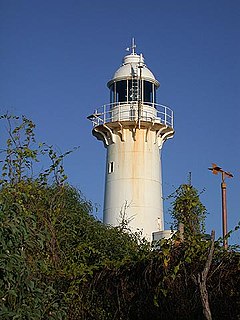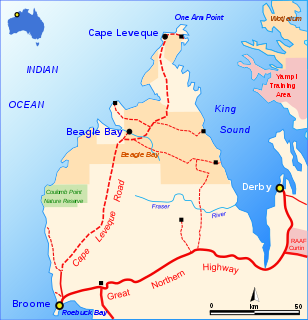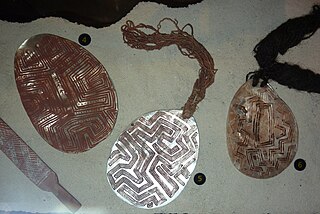
Broome, also known as Rubibi by the Yawuru people, is a coastal, pearling and tourist town in the Kimberley region of Western Australia, 1,681 km (1,045 mi) north of Perth. The estimated urban population was 13,984 in August 2016. It is the largest town in the Kimberley region.

The Kimberley is the northernmost of the nine regions of Western Australia. It is bordered on the west by the Indian Ocean, on the north by the Timor Sea, on the south by the Great Sandy and Tanami deserts in the region of the Pilbara, and on the east by the Northern Territory.

Cape York Peninsula is a large peninsula located in Far North Queensland, Australia. It is the largest unspoiled wilderness in northern Australia. The land is mostly flat and about half of the area is used for grazing cattle. The relatively undisturbed eucalyptus-wooded savannahs, tropical rainforests and other types of habitat are now recognized and preserved for their global environmental significance. Although much of the peninsula remains pristine, with a diverse repertoire of endemic flora and fauna, some of its wildlife may be threatened by industry and overgrazing as well as introduced species and weeds.

Denham is the administrative town for the Shire of Shark Bay, Western Australia. At the 2016 census, Denham had a population of 754. Located on the western coast of the Peron Peninsula 831 kilometres (516 mi) north of Perth, Denham is the westernmost publicly accessible town in Australia, and is named in honour of Captain Henry Mangles Denham of the Royal Navy, who charted Shark Bay in 1858. Today, Denham survives as the gateway for the tourists who come to see the dolphins at Monkey Mia, which is located 23 kilometres (14 mi) northeast of the town. The town also has an attractive beach and a jetty popular with those interested in fishing and boating.
Bardi is an endangered Australian Aboriginal language in the Nyulnyulan family, mutually intelligible with Jawi and possibly other dialects. It is spoken by the Bardi people at the tip of the Dampier peninsula and neighbouring islands. There are few fluent speakers in the 21st century, but efforts are being made to teach the Bardi language and culture at at least one school.
Broome Pearling Lugger Pidgin is a pidgin that sprang up in Broome, Western Australia in the early 20th century to facilitate communication between the various groups working in the pearling industry there—Japanese, Malays, Torres Strait Islanders, Koepangers, Hakka Chinese, Filipinos, a small number of Koreans, and local Indigenous Australians, mainly of the Bardi people but also Nyulnyul, Jabirr Jabirr, Jukun, Yawuru and Karajarri people. The name derives from the boats used for pearling, known as pearling luggers.

Cape Leveque is at the northernmost tip of the Dampier Peninsula in the Kimberley region of Western Australia. Cape Leveque is 240 kilometres (150 mi) north of Broome, and is remote with few facilities. Nevertheless, the Cape's sandy beaches are attracting an increasing number of visitors.

Pearling in Western Australia existed well before European settlement. Coastal dwelling Aboriginal people had collected and traded pearl shell as well as trepang and tortoise with fisherman from Sulawesi for possibly hundreds of years. After settlement, Aboriginal people were used as slave labour in the emerging commercial industry in a practice known as blackbirding. Pearling centred first around Nickol Bay and Exmouth Gulf and then around Broome to become the largest in the world by 1910.

The Shire of Broome is one of the four local government areas in the Kimberley region of northern Western Australia, covering an area of 55,796 square kilometres (21,543 sq mi), most of which is sparsely populated. The Shire's estimated population as at the 2016 census was 16,222 most of whom reside in the town of Broome. Many Aboriginal communities are within the Shire, notably Beagle Bay and Bardi.

Beagle Bay is a medium-sized Aboriginal community on the western side of the Dampier Peninsula, north of Broome in the Kimberley region of Western Australia.

King Sound is a large gulf in northern Western Australia. It expands from the mouth of the Fitzroy River, one of Australia's largest watercourses, and opens to the Indian Ocean. It is about 120 kilometres (75 mi) long, and averages about 50 kilometres (31 mi) in width. The port town of Derby lies near the mouth of the Fitzroy River on the eastern shore of King Sound. King Sound has the highest tides in Australia, and amongst the highest in the world, reaching a maximum tidal range of 11.8 metres (39 ft) at Derby. The tidal range and water dynamic were researched in 1997–1998.

The Cape Leveque Road is a regional Western Australian road that runs through pindan woodland for 205 kilometres (127 mi) between Broome and Cape Leveque on the Dampier Peninsula.

Riji are the pearl shells traditionally worn by Aboriginal men in the north-west part of Australia, around present day Broome. The word riji is from the Bardi language. Another word for it is jakuli.

The Lacepede Islands, sometimes referred to simply as the Lacepedes, are a group of four islands lying off the Kimberley coast of Western Australia, about 120 kilometres north of Broome.

Ardyaloon or One Arm Point, also known as Bardi, is an Aboriginal Australian community town on the Dampier Peninsula, in the Kimberley region of Western Australia. It is located 2,446 km (1,520 mi) north of Perth and the closest populated town is Derby. At the 2016 census, Bardi had a population of 365.

Lombadina is a medium-sized Aboriginal community on the north-western coast of Western Australia on Cape Leveque, north of Broome in the Kimberley region. The name is derived from the Aboriginal word, "Lollmardinard". The community is inhabited by the Bardi people.

Djarindjin is a medium-sized Aboriginal community located 170 km (110 mi) north of Broome in the Kimberley region of Western Australia, within the Shire of Broome. It is within the traditional lands of the Bardi and Jawi peoples.

The Bardi people, also spelt Baada or Baardi and other variations, are an Aboriginal Australian people, living north of Broome and inhabiting parts of the Dampier Peninsula in the Kimberley region of Western Australia. They are ethnically close to the Jawi people, and several organisations refer to the Bardi Jawi grouping, such as the Bardi Jawi Niimidiman Aboriginal Corporation Registered Native Title Body (RNTBC) and the Bardi Jawi Rangers.
The Jabirr Jabbirr are an Indigenous Australian people of the Kimberley region of Western Australia.

The Nyulnyul are an Aboriginal Australian people of the Kimberley region of Western Australia.














